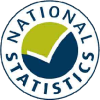Higher Education Student Statistics: UK, 2016/17 - Student numbers and characteristics
- Summary
- Student numbers and characteristics
- Where students come from and go to study
- Subjects studied
- Qualifications achieved
- Notes
How many students are in HE?
The total number of HE students stood at 2,317,880 in 2016/17, an increase of 2% from 2015/16. In 2016/17, for the first time, HE students registered at further education (FE) colleges in Wales (see Notes) have been included in the figures.
Figure 3 shows that there has been an increase of 26,645 masters taught students enrolling in their first year between 2015/16 and 2016/17. This coincides with the introduction of postgraduate loans for masters' students. Also notable in this table is that the number of part-time students have continuously declined between 2012/13 and 2016/17. In 2012/13, first year students studying part-time represented almost a third of all first year students, but by 2016/17 this figure decreased to just under a quarter. Trends vary by country of HE provider, with Wales and Scotland seeing an increase in part-time first year students between 2015/16 and 2016/17.
Figure 3 - HE student enrolments by level of study
2012/13 to 2016/17
Show:
Please note that 'Other undergraduate' includes any qualification not listed above (see definitions for a full list of qualifications). 'Total other undergraduate' includes all undergraduate qualifications excluding first degrees.
Who are HE students (widening participation)?
Figure 4 shows that there was a year on year decline in the number of students aged 30 and over, between 2012/13 and 2015/16. This is likely to be related to the decline in the number of part-time students, because the number of full-time students aged 30 and over increased in 2015/16 and 2016/17. Numbers of students aged 24 and under have increased year on year since 2012/13. This is a trend that is particularly noticeable amongst full-time students. Compared to this, Labour Force Survey data published by the Office for National Statistics (ONS) in August 2017, shows that between April to June 2013 and April to June 2017 there was no noticeable change in the proportion of people aged 16 to 24 who were in full-time education. At both points in time the proportion stood at 44%. However, the longer term trend (from March to May 1992 when comparable records began) has shown a substantial increase in the proportion of people aged 16 to 24 who were in full-time education (source: ONS).
Information on the sex of students as seen in figure 4 shows that 57% of all HE students were female in 2016/17. This differed by mode of study: 56% of full-time students were female compared to 60% of part-time students in 2016/17. It also differed by level of study, with 63% of other undergraduate students being female, compared with 48% of postgraduate (research) students. Participation rate statistics in higher education published by the Department for Education in September 2017 highlight the gap in sexes, and summarise that it continues to be more likely for a female to attend university than a male (source: Department for Education).
There has been a continued increase in the proportion of BME (Black and Minority Ethnic) students amongst those who are UK domiciled with known ethnicity over the last five years. This increase is reflected across both full and part-time students, although in 2016/17, 25% of full-time UK domiciled students were BME, compared to 17% of part-time UK domiciled students.
Figure 4 - HE student enrolments by personal characteristics
2012/13 to 2016/17
Show:
When viewing percentages in this table, please note that percentage calculations exclude unknown values.
Figure 5 shows widening participation information that is newly published material within this statistical first release. The data is only returned to HESA for students who apply through UCAS, so to align with the cohort who typically enter through this route, the table has been restricted to undergraduate UK domiciled full-time students. Please note that POLAR low participation data has not been produced for HE providers in Scotland, to align with the HESA Performance Indicators. As such, low participation figures for all countries in a given year, will not sum to totals represented at the bottom of the table.
Low participation neighbourhood information in figure 5 shows that more UK domiciled full-time undergraduate students from a low participation neighbourhood were enrolled in HE in 2016/17 compared with figures for the previous four years. This pattern is repeated for first year UK domiciled full-time undergraduates from low participation neighbourhoods. Data published by UCAS in August 2017 shows an upward trend in the number of acceptances from those from a low participation neighbourhood (POLAR3 quintile 1) although those figures are based on UK domiciled 18 year olds (source: UCAS). The POLAR3 lookup for low participation neighbourhoods is created and maintained by HEFCE and can be downloaded from their website.
Figure 5 - HE undergraduate UK domiciled full-time student enrolments by participation characteristics
2012/13 to 2016/17

Embargo
11 January 2018, 9:30
Coverage
UK
Release frequency
Annual - view all releases (1998/99 - onwards)
Pre-release access
View pre-release access list for this release
Themes
Children, education and skills
Issued by
HESA, 95 Promenade, Cheltenham, GL50 1HZ
Press enquiries
01242 211120
Public enquiries
01242 211133
Statistician
Rebecca Mantle




